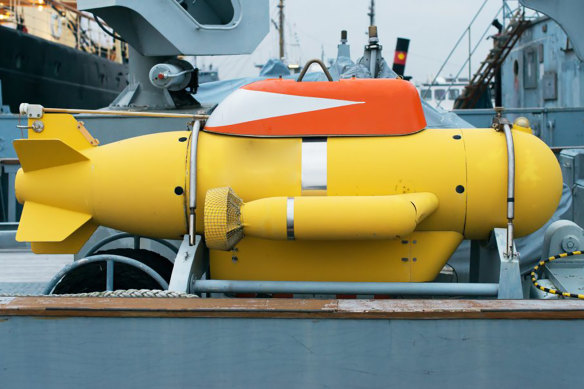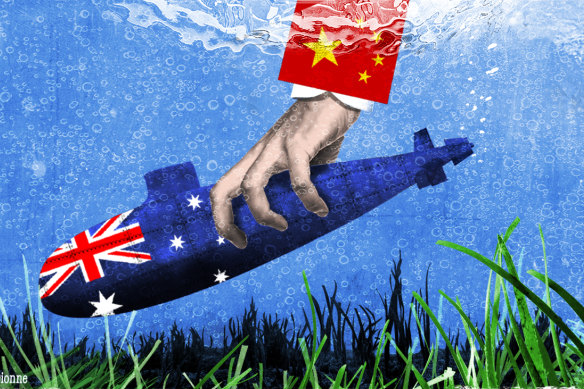
With the submarine announcement, Prime Minister Anthony Albanese committed Australia to a project that started as a thought bubble from his predecessor, Scott Morrison, whose only decision fully supported by his own party was that he stand down as leader. That is an unfortunate pedigree, and the submarine decision lives up to it.
Manned submarines are nearing the end of their utility in hostile waters because of developments in smart sea mines, unmanned underwater vehicles (UUVs) and underwater sensors. China has already made a strong start on this, and will deploy them in large numbers in its coastal region and strategically important areas of the South China Sea and East China Sea.
An unmanned underwater vehicle. China is investing heavily in the kind of technology that could detect once-stealthy submarines.Credit:Via DepositPhotos
Australia plans to buy at least three American Virginia-class nuclear-powered submarines while it proceeds to build its SSN-AUKUS subs. The acoustic signature of the Virginia-class is known to China. It will be programmed into China’s defensive and offensive capabilities, which are cheap counters to an extremely expensive submarine – one that carries 132 increasingly vulnerable sailors.
By the time Australia gets the submarines from the US in the 2030s, it will be simply too dangerous to deploy them to contested areas that could take advantage of their performance and firepower. They will be restricted to home or benign waters, undercutting their main justification. Russia has already shown this to be true in the air. Its air force rarely ventures into contested territory, preferring to fire missiles from a distance. That is also the future of underwater warfare.
As for the nuclear-powered submarines to be built in South Australia, the ambitious schedule is to deliver the first by the early 2040s. By the 2050s, however, it would be surprising if there would be any place for manned submarines at all. The oceans are becoming transparent through the development of new sensors. Cheap, ubiquitous smart sea-mines, sensors and UUVs will render them obsolete.
The submarine decision is not strong or tough on China. It is dumb on China by the very people who talk up the threat it poses.
Illustration: Dionne GainCredit:
China is complaining about the submarine announcement as it attempts to foster support among developing countries, but Beijing will be secretly laughing all the way to the UUV factory. It will not have escaped China’s attention that the production of Virginia-class submarines is already under pressure to meet US navy requirements of two a year. Increasing production output is costly and difficult.
That means the boats that Australia gets will probably not add to the total number of submarines deployed against China.
Even non-military justifications of jobs and capability-building are hollow. The industry developed to support submarines will be narrow and focused on existing technologies, offering limited if any self-sustaining benefits or export potential.
The tragedy is exacerbated by the realisation that the submarines deal – possibly priced at about $368 billion – constitutes the biggest transfer of wealth from Australia to another country in its history. You have to go back to times of colonial exploitation to discover an arrangement so uneven. And ironically, it is the result of Australia pleading for it.
This project condemns the Australian taxpayer to the life of the mythical Sisyphus, who was sentenced to push a boulder up a mountain for eternity. In a modern version of this cruel suffering, the taxpayer will have to fill ever-growing defence buckets for generations to come. More and more money for a project that will deliver less and less benefit. Cruel indeed.
The colossal expense of the nuclear-powered submarines means that long-term, meaningful defence capabilities will be foregone, and Australia will be less secure for it.
Australia should instead be intimidating in defence of its territory, and be capable of acting decisively in concert with others to defend common interests, including the US. It starts with Australia securing its region with further investment in the JORN over-the-horizon radar in the country’s north; acquiring great quantities of smart sea-mines to protect Australia’s coastal cities and the approaches to its ports; buying more fighter aircraft to dominate the sea and air gap to Australia’s north; purchasing new, off-the-shelf conventionally powered submarines to make the narrow straits and choke points to Australia’s north impassable to hostile navies; acquiring more drones and UUVs; bolstering special forces and light infantry that can be deployed quickly to disrupt and destroy enemy capabilities; and stockpiling large numbers of missiles to protect Australian cities and bases and devastate an enemy at range.
All of this at a fraction of the cost of the nuclear-powered submarines.
There are two things that can support this effort. The first is to invest heavily in world-leading research and development, including artificial intelligence and machine-learning, quantum computing, cryptography, communications and sensors, and stealth coatings and smart materials. Australia, with growing capabilities in stealth and coatings, should approach Turkey, a world leader in the production of military drones, to conduct joint research.
This leads to the second buttress of formidable and sustainable security for Australia: working collaboratively with the countries of its region. Indonesia, a tech-savvy, app-enabled country, has much to offer. Building patterns of co-operation can lead to trust and a willingness to act in concert against an outside power that might seek to impose its will.
Australia has the opportunity to make itself an anchor of defence capability in the region, and a valuable member of South-East Asia’s security community. And Australia needs to re-establish itself as the partner of choice among Pacific nations.
The prudent planning of defence preparation requires genuine intellectual rigour. Instead, all that is evident in the submarine announcement is intellectual rigor mortis, and the realisation of an idea of a former prime minister who was more famous for marketing than substance.
The Opinion newsletter is a weekly wrap of views that will challenge, champion and inform your own. Sign up here.
Most Viewed in Politics
From our partners
Source: Read Full Article

